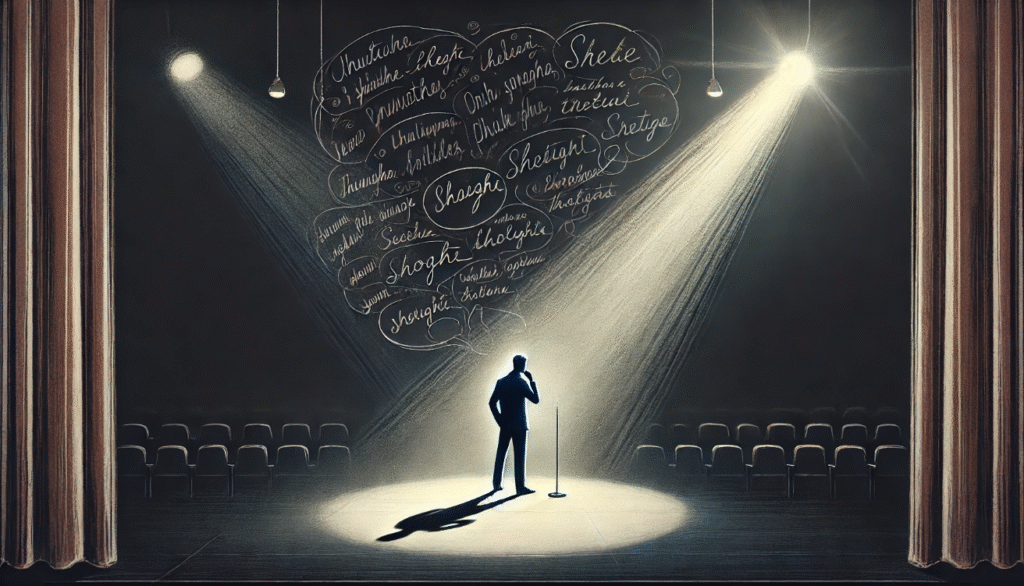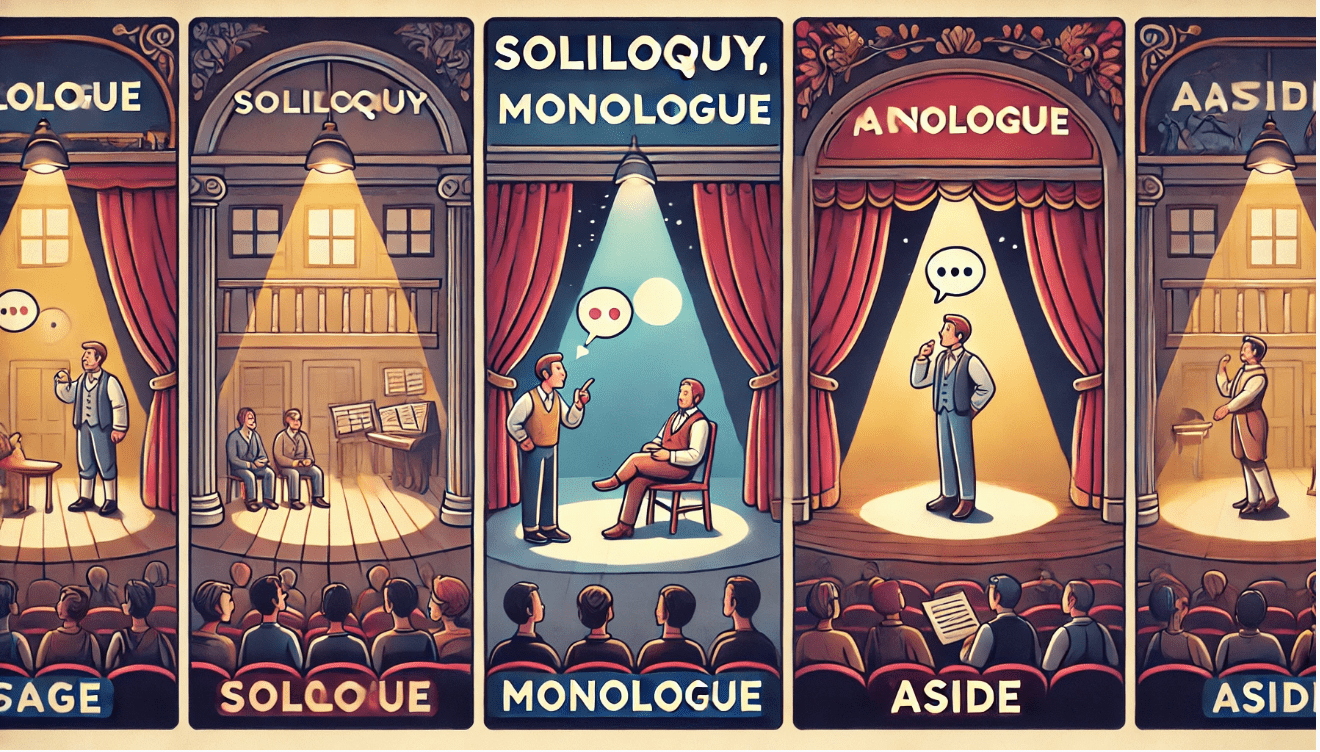
How Soliloquies in Literature Deepen Character Exploration: Unlocking Their Narrative Power
Ever wondered what’s really going on inside a character’s mind? 🤔 In literature, soliloquies are like secret keys that unlock a character’s deepest thoughts, fears, and dreams—revealing what no one else in the story gets to hear. The function of soliloquies in character exploration is to pull back the curtain, letting you connect with characters like Hamlet or Lady Macbeth on a profound level. Whether you’re a student decoding Shakespeare, a writer crafting compelling characters, or a literature lover craving richer stories, this article will show you how soliloquies work their narrative magic and how to analyze them like a pro. Keep reading to discover practical tips that make complex characters come alive! 😊
Table of Contents
Toggle1: What Are Soliloquies and Why Do They Matter?
Ever read a book or watched a play and felt like you were inside a character’s head? That’s the magic of a soliloquy! 😊 A soliloquy is when a character speaks their thoughts aloud, alone on stage, revealing their deepest feelings, fears, or plans. It’s like eavesdropping on their private diary. Unlike regular dialogue, soliloquies let you hear what a character really thinks, without filters.
What Makes a Soliloquy Special?

Soliloquies aren’t just random speeches. They’re a powerful tool in plays and literature, especially in classics like Shakespeare’s Hamlet or Sophocles’ Greek tragedies. Here’s how they work:
- Solo Act: The character is alone (or thinks they are), speaking to themselves, not others.
- Raw Honesty: They share unfiltered emotions, doubts, or schemes, like Hamlet wrestling with life and death.
- Story Boost: Soliloquies reveal motives, advance the plot, or highlight big themes like love or betrayal.
How Are Soliloquies Different?
Not every speech is a soliloquy! Here’s a quick breakdown:
- Soliloquy vs. Monologue: A monologue is any long speech, even if it’s to other characters. Soliloquies are private, solo moments.
- Soliloquy vs. Aside: An aside is a brief comment to the audience, often with others on stage. Soliloquies are longer and more introspective.
2: How Soliloquies Deepen Character Exploration
Ever felt like you truly know a character, as if they’re a close friend spilling their secrets? That’s the power of soliloquies! 😊 They pull back the curtain on a character’s mind, letting you see their raw emotions, conflicts, and desires. The function of soliloquies in character exploration is to make fictional people feel real and relatable. Let’s dive into how they work their magic.
Revealing Inner Thoughts and Emotions
Soliloquies give you a front-row seat to a character’s heart. When they’re alone, they drop their guard and share what they hide from others. Take Hamlet’s famous “To be or not to be” speech in Hamlet. He wrestles with life, death, and purpose, showing his fear and indecision. This raw honesty helps you understand his struggles, making him more than just a prince—he’s human.
Showcasing Moral and Psychological Conflicts
Characters often face tough choices, and soliloquies lay bare their inner battles. In Macbeth, Macbeth’s soliloquy before killing Duncan reveals his ambition clashing with his guilt. You see him torn between power and morality, which makes his downfall gripping. By exposing these conflicts, soliloquies add layers to characters, turning them into complex figures you can’t help but think about.

Building Audience Connection
Soliloquies create a special bond between you and the character. When Iago in Othello shares his sneaky plans in a soliloquy, you’re drawn into his twisted mind, even if you don’t like him! This intimacy makes you care about the story, whether you’re rooting for the hero or fascinated by the villain. It’s like the character is confiding in you, making the experience personal and unforgettable.
3: Practical Ways Soliloquies Solve Reader Pain Points
Struggling to understand complex characters or write compelling ones? Soliloquies are your secret weapon! 😊 They help you decode characters’ minds and craft stories that resonate. Whether you’re a student tackling essays, a writer building authentic characters, or a literature lover wanting deeper insights, the function of soliloquies in character exploration solves real problems. Here’s how to use them practically to boost your confidence and skills.
For Students: Ace Your Literary Analysis
Soliloquies are goldmines for essays and exams. They reveal a character’s motivations, making it easier to argue how they develop. For example, in Hamlet, Hamlet’s soliloquy about revenge shows his hesitation, perfect for analyzing his arc. Tip: Pick a soliloquy, note its key emotions, and tie them to the story’s themes in your paper. This approach makes your arguments stronger and more convincing.
For Writers: Craft Authentic Characters
 Want to create characters that feel real? Soliloquies let you explore their hidden fears or desires. Try writing a soliloquy during drafting to dig into what drives your character. For instance, a hero debating a risky choice can reveal their bravery or doubt. Tip: Write a 100-word soliloquy for your character, focusing on a personal conflict, to uncover their depth and make them unforgettable.
Want to create characters that feel real? Soliloquies let you explore their hidden fears or desires. Try writing a soliloquy during drafting to dig into what drives your character. For instance, a hero debating a risky choice can reveal their bravery or doubt. Tip: Write a 100-word soliloquy for your character, focusing on a personal conflict, to uncover their depth and make them unforgettable.
For Literature Enthusiasts: Enjoy Stories More
Soliloquies make reading or watching plays more exciting by revealing characters’ true selves. In Romeo and Juliet, Juliet’s soliloquy about her love for Romeo shows her vulnerability, making her more relatable. Tip: Keep a “soliloquy journal” while reading. Jot down what each soliloquy reveals about the character’s heart—it’ll transform how you experience the story.
4: Analyzing Soliloquies Like a Pro 😊
Soliloquies are a window into a character’s soul. They reveal thoughts, emotions, and motivations that might otherwise stay hidden. But how do you analyze them effectively? Whether you’re a student, a book lover, or just curious, here’s a simple, step-by-step guide to unlock the power of soliloquies like a pro. Let’s dive in! 🚀
1: Understand the Context 📚
Before dissecting a soliloquy, know where it fits in the story. What’s happening in the plot? What’s the character’s situation? For example, in Hamlet, when Hamlet says, “To be, or not to be,” he’s wrestling with life-and-death decisions. Context gives you the “why” behind the words. Ask yourself:
- What events led to this moment?
- Who is the character speaking to (themselves or the audience)?
- What’s at stake for them?
This sets the stage for deeper analysis. Without context, you’re just reading words on a page.
2: Identify the Emotional Core ❤️
Soliloquies are emotional goldmines. They often reveal a character’s deepest fears, desires, or conflicts. Look for the dominant emotion. Is it anger, despair, hope, or guilt? In Macbeth, when Lady Macbeth says, “Out, damned spot!” she’s consumed by guilt. Pinpointing this emotion helps you understand the character’s inner world. Try asking:
- What’s the character feeling right now?
- How does this emotion drive their actions or decisions?
Jot down key words or phrases that signal the emotion. This makes it easier to track the character’s mindset.
3: Break Down the Language 🔍
Soliloquies often use poetic or figurative language, so don’t skim over the words! Look for metaphors, similes, or repeated ideas. For instance, in Romeo and Juliet, Romeo’s soliloquy about Juliet as the “sun” uses light imagery to show his love. To analyze:
- Highlight vivid or unusual words.
- Note patterns like repetition or contrasts.
- Ask: How does the language reflect the character’s state of mind?
If the language feels tricky, try paraphrasing it in your own words. This clarifies the meaning and makes it less intimidating.
4: Explore the Character’s Conflict ⚔️
Most soliloquies center on a struggle—internal or external. Does the character face a moral dilemma, like Hamlet debating revenge? Or are they battling self-doubt, like Juliet questioning her loyalty? Identify the conflict and how it shapes the character. Ask:
- What’s the main problem they’re grappling with?
- How does this soliloquy show their growth or stagnation?
This step reveals how the soliloquy moves the story forward or deepens the character’s arc.
5: Connect to the Bigger Picture 🌍
Soliloquies aren’t just about the character—they often tie to the story’s themes. In Othello, Iago’s soliloquies about jealousy reflect the play’s broader exploration of betrayal. Think about:
- How does this soliloquy relate to the story’s main ideas?
- Does it foreshadow future events or echo earlier moments?
This helps you see the soliloquy’s role in the narrative, making your analysis richer and more insightful.
Want to find soliloquies in your favorite stories? Here’s how:
- In books: Look for long, reflective passages or moments where the character seems to “think out loud.”
- In movies/TV: Watch for voiceovers, fourth-wall breaks, or scenes where a character speaks alone.
- Ask yourself: What does this reveal about the character’s heart? How does it connect to the story’s themes?
Try keeping a journal while reading or watching. Jot down soliloquies you notice and what they teach you about the character. It’s a fun way to feel like a detective! 🕵️♀️
Examples to Explore ✨
Here are a few modern works with standout soliloquies to check out:
- Literature: A Man Called Ove by Fredrik Backman—Ove’s grumpy inner thoughts reveal his soft side.
- TV: Breaking Bad—Walter White’s rare solo moments expose his moral spiral.
- Movies: Deadpool—Wade Wilson’s cheeky asides to the audience are soliloquies with a comedic twist.
Why This Matters 🎭
Soliloquies in modern stories help us connect with characters on a deeper level. They show us that even in today’s fast-paced media, the human need to reflect and confess is universal. By spotting and analyzing these moments, you’ll unlock richer insights into the stories you love—and maybe even learn a bit about yourself. 😊
6: Common Mistakes to Avoid When Interpreting Soliloquies 🚫
Soliloquies are like puzzles—exciting to solve but easy to misread if you’re not careful. Whether you’re a student, book lover, or casual reader, avoiding these common mistakes will help you unlock the true meaning of a soliloquy. Let’s break down the pitfalls and how to steer clear of them for sharper, more confident analysis. Ready? Let’s dive in! 😊
1: Ignoring the Context 🕵️♀️
Jumping into a soliloquy without understanding its place in the story is a recipe for confusion. For example, Hamlet’s “To be, or not to be” soliloquy isn’t just about life and death—it’s tied to his indecision about revenge. Always check:
- What’s happening in the plot before the soliloquy?
- What’s the character’s situation or emotional state?
Fix: Skim the scene or chapter before the soliloquy. This grounds you in the “why” behind the words, making your interpretation more accurate.
2: Taking Words at Face Value 🙈
Soliloquies often use metaphors, irony, or hidden meanings. If you only focus on the literal words, you’ll miss the deeper message. In Macbeth, when Lady Macbeth says, “Out, damned spot!” it’s not just about a stain—it’s her guilt consuming her.
- Look for figurative language like metaphors or symbols.
- Ask: What’s the character really saying?
Fix: Highlight unusual phrases and think about their emotional or thematic weight. Paraphrase tricky lines to uncover their true intent.
3: Overlooking the Character’s Development 🌱
A soliloquy isn’t just a random outburst—it often shows how a character is changing (or not). If you treat it as a standalone speech, you miss its role in the character’s arc. For instance, Iago’s soliloquies in Othello reveal his growing malice over time.
- Ask: How does this soliloquy show the character’s growth, doubts, or decline?
Fix: Compare the soliloquy to earlier or later moments in the story. Does it mark a turning point or reinforce a trait?
4: Forgetting the Audience Connection 🎭
In plays, soliloquies often speak directly to the audience, building a bond. Ignoring this can make you miss the storyteller’s intent. In modern media, like Fleabag, the main character’s asides make us feel like her confidant.
- Consider: Is the character sharing a secret with us? Why?
Fix: Imagine you’re the audience the character is addressing. This helps you catch the emotional or narrative purpose of the soliloquy.
5: Overcomplicating the Analysis 🤯
It’s easy to get lost in fancy theories or jargon, especially with complex works like Shakespeare. But soliloquies are meant to reveal, not confuse. Overthinking can cloud the character’s core emotions or motives.
- Keep it simple: What’s the character feeling, and why does it matter?
7: How to Use Soliloquies in Your Own Writing ✍️
Want to make your characters leap off the page? Soliloquies are a powerful tool to reveal their inner thoughts, emotions, and conflicts. Whether you’re writing a novel, short story, or screenplay, adding soliloquies can deepen your characters and captivate readers. Here’s a beginner-friendly guide to using soliloquies effectively in your writing. Let’s get started! 🚀
Why Use Soliloquies? 🌟
Soliloquies let readers hear your character’s unfiltered voice. They’re perfect for showing what’s really going on inside their head—stuff they wouldn’t say out loud. Think of it as a secret conversation with the reader. Use them to:
- Reveal hidden fears, desires, or secrets.
- Show a character’s internal conflict or growth.
- Build a stronger connection between the character and the audience.
Ready to try? Here’s how to craft soliloquies that shine.
1: Choose the Right Moment ⏰
A soliloquy works best when your character is alone, reflecting on something big. Maybe they’re facing a tough choice, like in Hamlet, or wrestling with guilt, like Lady Macbeth. Pick a moment where:
- The character is at a turning point in the story.
- They need to process intense emotions or decisions.
Tip: Place the soliloquy after a dramatic event, like a betrayal or a victory, to maximize its impact.
2: Match the Voice to the Character 🗣️
Your soliloquy should sound like your character, not you. A teenager might ramble with slang, while a soldier might use sharp, clipped thoughts. In The Catcher in the Rye, Holden’s inner monologues are raw and conversational, perfectly matching his personality. To nail this:
- Use the character’s unique vocabulary and tone.
- Reflect their emotions—angry, confused, hopeful?
Tip: Try writing the soliloquy as a stream of consciousness first, then polish it to fit the story’s flow.
3: Keep It Natural and Focused 🌿
A good soliloquy feels real, not like a lecture. Avoid overloading it with plot details or unnatural exposition. Focus on one key emotion or conflict. For example, in a modern story, a character might think: “Why did I lie to her? Now she’s gone, and I’m stuck with this mess.” Keep it:
- Short and punchy, unless the character is spiraling.
- Centered on a single idea, like doubt, love, or regret.
Tip: Read it aloud to check if it sounds like something your character would actually think.
4: Use the Format That Fits Your Medium 🎭
Soliloquies look different depending on your story’s format:
- Novels: Use internal monologues, often in italics or first-person thoughts. Example: I can’t do this anymore, she thought, staring at the empty chair.
- Plays: Write a clear stage direction, like [Alone], and let the character speak directly to the audience.
- Screenplays: Try voiceovers or a character talking to themselves on screen, like in Fight Club.
Tip: Experiment with formatting, but make sure it’s clear the character is speaking internally or alone.
5: Tie It to the Story’s Themes 🔗
Great soliloquies do more than reveal character—they echo the story’s bigger ideas. If your story is about betrayal, let the soliloquy explore trust or guilt. In The Handmaid’s Tale, Offred’s inner thoughts often reflect themes of freedom and oppression. Ask:
- How does this soliloquy connect to the story’s main message?
- Does it hint at what’s coming next or reflect past events?
Tip: Jot down your story’s core themes before writing the soliloquy to keep it aligned.
The Lasting Power of Soliloquies 🎭
 Soliloquies are more than just dramatic speeches—they’re a gateway to understanding characters and stories on a deeper level. From Shakespeare’s tormented Hamlet to modern characters like Fleabag, these inner monologues reveal raw emotions, hidden conflicts, and universal truths. By analyzing soliloquies, you uncover what makes characters tick, and by writing them, you bring your own stories to life. 😊
Soliloquies are more than just dramatic speeches—they’re a gateway to understanding characters and stories on a deeper level. From Shakespeare’s tormented Hamlet to modern characters like Fleabag, these inner monologues reveal raw emotions, hidden conflicts, and universal truths. By analyzing soliloquies, you uncover what makes characters tick, and by writing them, you bring your own stories to life. 😊
Whether you’re a reader, student, or writer, soliloquies offer a chance to connect with the human experience. They show us that even fictional characters wrestle with doubts, dreams, and decisions just like we do. Use the tips from this article—context, emotion, language, and theme—to dive into soliloquies with confidence. Avoid common pitfalls, and don’t be afraid to experiment in your own writing. ✍️
So, what’s next? Pick up a book, watch a show, or start writing a soliloquy of your own. Notice those quiet moments where characters bare their souls, and let them inspire you. Soliloquies aren’t just a literary trick—they’re a reminder that every voice, real or fictional, has a story worth hearing. Keep exploring, and let those inner voices shine! 🚀
Frequently Asked Questions (FAQs)
1. What is a soliloquy in literature?
A soliloquy is a moment in a story or play where a character speaks their thoughts aloud, usually alone, revealing their inner feelings or conflicts. It’s like a window into their mind, showing what they’re too afraid or unable to say to others. Famous examples include Hamlet’s “To be, or not to be” speech in Shakespeare’s Hamlet.
2. How do soliloquies deepen character exploration?
Soliloquies reveal a character’s true emotions, motivations, and struggles, giving readers or viewers insight into their personality. They show what’s hidden from other characters, like fears or secret plans, making the character feel more real and relatable. For example, in Macbeth, soliloquies expose Macbeth’s guilt and ambition.
3. What’s the difference between a soliloquy and a monologue?
A soliloquy is a type of monologue where a character speaks their private thoughts alone, often to the audience. A monologue can be spoken to other characters or in a group setting and doesn’t always reveal inner thoughts. Soliloquies are more personal, like Iago’s scheming speeches in Othello.
4. Are soliloquies still used in modern literature and media?
Yes, soliloquies appear in modern books as internal monologues and in movies or TV as voiceovers or fourth-wall breaks. For example, in Fleabag, the main character talks directly to the audience, sharing her inner struggles. They’re still a powerful way to show a character’s mind.
5. How can I analyze a soliloquy effectively?
To analyze a soliloquy, check the story’s context, identify the character’s emotions, and look for key themes or imagery in the language. Ask what the character is struggling with and how it connects to the bigger story. For instance, Juliet’s soliloquy in Romeo and Juliet reveals her fear and love, tying to the theme of forbidden romance.
6. Can I use soliloquies in my own writing?
Absolutely! Use soliloquies to show your character’s inner thoughts during a key moment, like a tough decision or emotional conflict. Write in their unique voice, keep it focused, and tie it to the story’s themes. For example, a character might reflect on a betrayal with raw, honest thoughts to draw readers in.
7. What are common mistakes to avoid when interpreting soliloquies?
Don’t ignore the story’s context or take the words too literally, as soliloquies often use metaphors or irony. Avoid overcomplicating the analysis—focus on the character’s emotions and conflict instead. Always consider how the soliloquy fits into the character’s growth or the story’s themes.
8. Why are soliloquies important for understanding stories?
Soliloquies give direct access to a character’s thoughts, helping you understand their motivations and the story’s deeper themes. They create empathy by showing struggles we all relate to, like doubt or hope. In works like The Handmaid’s Tale, they make complex characters feel human and drive the narrative forward.
